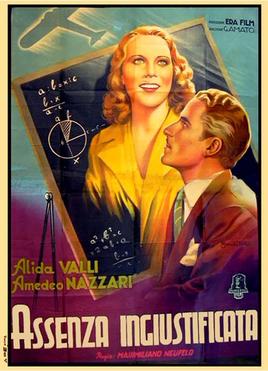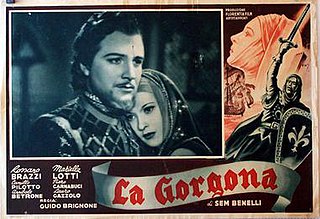
Andrea Checchi was a prolific Italian film actor.

Invisible Chains is a 1942 Italian drama film directed by Mario Mattoli and starring Alida Valli, Carlo Ninchi and Giuditta Rissone. It was shot at the Cinecittà Studios in Rome. The film's sets were designed by the art directors Ottavio Scotti and Mario Rappini.

Lively Teresa is a 1943 Italian "white-telephones" comedy film directed by Mario Mattoli and starring Lilia Silvi, Roberto Villa and Carlo Ninchi. It was produced in the style of the White Telephone comedies popular during the Fascist era.

Lauro Gazzolo was an Italian actor and voice actor.

House of Ricordi is a 1954 French-Italian historical biographical melodrama film based on the early history of the Italian music publishing house Casa Ricordi. It is directed by Carmine Gallone and stars Märta Torén, Marcello Mastroianni and Micheline Presle. The Ricordi family's interactions with many of the great composers of the nineteenth century are portrayed. The film's sets were designed by Mario Chiari. It was shot at the Cinecittà Studios and on location in Milan, Paris and Rome.

Mid-Century Loves is a 1954 Italian anthology historical melodrama film consisting of five segments directed by Glauco Pellegrini, Pietro Germi, Mario Chiari, Roberto Rossellini and Antonio Pietrangeli.

Malombra is a 1942 Italian drama film directed by Mario Soldati and starring Isa Miranda, Andrea Checchi and Irasema Dilián. It is based on the novel Malombra by Antonio Fogazzaro, which had previously been adapted into a 1917 silent film of the same title. It was made at Cinecittà with sets designed by Gino Brosio. It was produced by Riccardo Gualino's Lux Film. It belongs to the movies of the calligrafismo style.

Red Tavern is a 1940 Italian "white-telephones" comedy film directed by Max Neufeld and starring Alida Valli, André Mattoni, and Lauro Gazzolo. It was made at Cinecittà in Rome. A young woman eventually marries a count after a series of misunderstandings.

Unjustified Absence is a 1939 Italian "white-telephones" comedy film directed by Max Neufeld and starring Alida Valli, Amedeo Nazzari and Lilia Silvi. A girl leaves school to marry a doctor, but becomes annoyed by his constant absences and decides to secretly resume her studies.

Lilia Silvi was an Italian film actress. Silvi was one of several young actresses presented as an Italian equivalent to the Canadian-born Hollywood star Deanna Durbin. She appeared opposite Amedeo Nazzari, the most popular Italian star of the era, in five films.

The Ways of Sin is a 1946 Italian historical melodrama film directed by Giorgio Pastina and starring Jacqueline Laurent, Leonardo Cortese and Carlo Ninchi. The film is a melodrama set in Sardinia at the beginning of the twentieth century. It is based on a novel by Grazia Deledda. The film was shot in the Apennine Mountains rather than Sardinia.

The Gorgon is a 1942 Italian historical drama film directed by Guido Brignone and starring Mariella Lotti, Rossano Brazzi and Camillo Pilotto. It was adapted from the play by Sem Benelli and is set in the Republic of Pisa during the eleventh century.
The Last of the Bergeracs is a 1934 Italian comedy film directed by Gennaro Righelli and starring Ketty Maya, Arturo Falconi and Italia Almirante-Manzini.

Big Shoes is a 1940 Italian "white-telephones" comedy film directed by Dino Falconi and starring Amedeo Nazzari, Lilia Silvi and Elena Altieri. It is based on a play by Sándor Hunyady which had previously been turned into a 1939 Hungarian film Istvan Bors.

The Taming of the Shrew is a 1942 Italian comedy film directed by Ferdinando Maria Poggioli and starring Amedeo Nazzari, Lilia Silvi and Lauro Gazzolo. It is based on William Shakespeare's play The Taming of the Shrew, with the setting updated to modern-day Rome.
Blood Feud is a 1961 Italian film starring Belinda Lee.

One Hundred Thousand Dollars is a 1940 Italian "white-telephones" comedy film directed by Mario Camerini and starring Assia Noris, Amedeo Nazzari and Lauro Gazzolo.

The Black Panther is a 1942 Italian crime film directed by Domenico Gambino and starring Leda Gloria, Dria Paola and Lauro Gazzolo. It was shot at the Titanus Studios in Rome. The film's sets were designed by the art directors Arrigo Equini and Vincenzo Pantano.

The Secret of Villa Paradiso is a 1940 Italian crime drama film directed by Domenico Gambino and starring Luisa Ferida, Giovanni Grasso and Mino Doro. It was shot at the Cinecittà Studios in Rome. The film's sets were designed by the art director Salvo D'Angelo.

Violets in Their Hair is a 1942 Italian comedy drama film directed by Carlo Ludovico Bragaglia and starring Lilia Silvi, Irasema Dilián and Carla Del Poggio. It was based on a novel of the same title by Luciana Peverelli. It was shot at the Cinecittà Studios in Rome. The film's sets were designed by the art directors Piero Filippone and Mario Rappini.

















